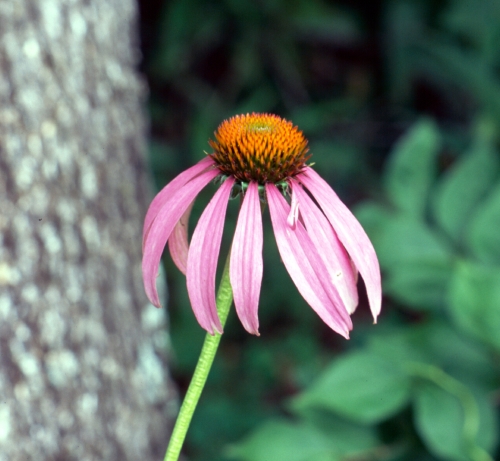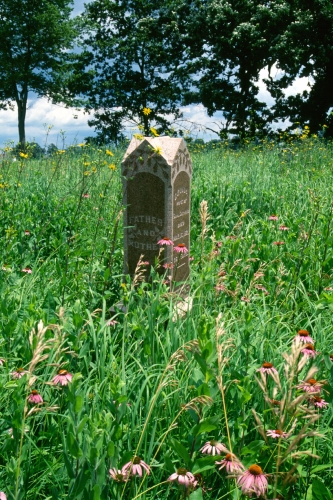Plants and Animals
Echinacea purpurea Purple coneflower
Key Characteristics
Stout perennial forb (1 m or more) of mesic prairies; leaves broadly lanceolate, toothed, hairy; flowers large with a dark central disk and numerous purple drooping petals.
Status and Rank
US Status: No Status/Not Listed
State Status: X - Presumed extirpated (legally 'threatened' if rediscovered)
Global Rank: G5 - Secure
State Rank: SX - Presumed extirpated
Occurrences
| County | Number of Occurrences | Year Last Observed |
|---|---|---|
| Kalamazoo | 1 | 1946 |
| Kent | 1 | 1891 |
| St. Joseph | 1 | 1838 |
| Washtenaw | 1 | 1868 |
Information is summarized from MNFI's database of rare species and community occurrences. Data may not reflect true distribution since much of the state has not been thoroughly surveyed.
Habitat
Found in prairie remnants. Many populations of this species are introduced, and only naturally occurring ones are tracked. The last undisputed wild populations have not been observed since the late 1800s.
Natural Community Types
For each species, lists of natural communities were derived from review of the nearly 6,500 element occurrences in the MNFI database, in addition to herbarium label data for some taxa. In most cases, at least one specimen record exists for each listed natural community. For certain taxa, especially poorly collected or extirpated species of prairie and savanna habitats, natural community lists were derived from inferences from collection sites and habitat preferences in immediately adjacent states (particularly Indiana and Illinois). Natural communities are not listed for those species documented only from altered or ruderal habitats in Michigan, especially for taxa that occur in a variety of habitats outside of the state.
Natural communities are not listed in order of frequency of occurrence, but are rather derived from the full set of natural communities, organized by Ecological Group. In many cases, the general habitat descriptions should provide greater clarity and direction to the surveyor. In future versions of the Rare Species Explorer, we hope to incorporate natural community fidelity ranks for each taxon.
Associated Plants
Big bluestem, little bluestem, Indian grass, bee-balm, butterfly weed, blazing star, and green milkweed.
Management Recommendations
Widespread via plantings, but not known to be extant via any known native populations. If found, it would likely benefit from prescribed burning and control of woody species.
Survey Methods
Random meander search covers areas that appear likely to have rare taxa, based on habitat and the judgment of the investigator.
-
Meander search
-
Survey Period: From first week of June to fourth week of September
-
References
Survey References
- Elzinga, C.L., D.W. Salzer, and J.W. Willoughby. 1998. Measuring and Monitoring Plant Populations. The Nature Conservancy and Bureau of Land Management, Denver. BLM Technical Reference 1730-1. 477pp.
- Goff, G.F., G.A. Dawson, and J.J. Rochow. 1982. Site examination for Threatened and Endangered plant species. Environmental Management 6(4): 307-316
- Nelson, J.R. 1984. Rare Plant Field Survey Guidelines. In: J.P. Smith and R. York. Inventory of rare and endangered vascular plants of California. 3rd Ed. California Native Plant Society, Berkeley. 174pp.
- Nelson, J.R. 1986. Rare Plant Surveys: Techniques For Impact Assessment. Natural Areas Journal 5(3):18-30.
- Nelson, J.R. 1987. Rare Plant Surveys: Techniques for Impact Assessment. In: Conservation and management of rare and endangered plants. Ed. T.S. Elias. California Native Plant Society, Sacramento. 8pp.
Technical References
- Antonio, T.M. and S. Masi. 2001.The Sunflower Family in the Upper Midwest. A Photographic Guide to the Asteraceae in Illinois, Indianan, Iowa, Michigan, Minnesota and Wisconsin. Indiana Academy of Science, Indianapolis. 421pp.
- Fisher, T.R. 1988. The Dicotyledoneae of Ohio. Part 3. Asteraceae. Ohio State University Press, Columbus. 280pp.
- Flora of North America Editorial Committee. 2006. Flora of North America, North of Mexico. Volume 21: Magnoliophyta: Asteridae (in part): Asteraceae, part 3. Oxford University Press, New York. 616pp.
- Gleason, H. A., and A. Cronquist. 1991. Manual of Vascular Plants of Northeastern United States and Adjacent Canada. Second edition. The New York Botanical Garden, Bronx. 910pp.
- Gray, A. 1950. Gray's Manual of Botany; eighth ed. Van Nostrand Reinghold, New York. 1632pp.
- Holmgren, N.H. 1998. Illustrated Companion to Gleason and Cronquist's Manual. Illustrations of the vascular plants of Northeastern United States and adjacent Canada. New York Botanical Garden, Bronx. 937pp.
- Swink, F. and G. Wilhelm. 1994. Plants of the Chicago Region, 4th ed. Indiana Academy of Science, Indianapolis. 921pp.
- Voss, E.G. 1996. Michigan Flora. Part III. Dicots (Pyrolaceae-Compositae). Bulletin of the Cranbrook Institute of Science and University of Michigan Herbarium. 622pp.



